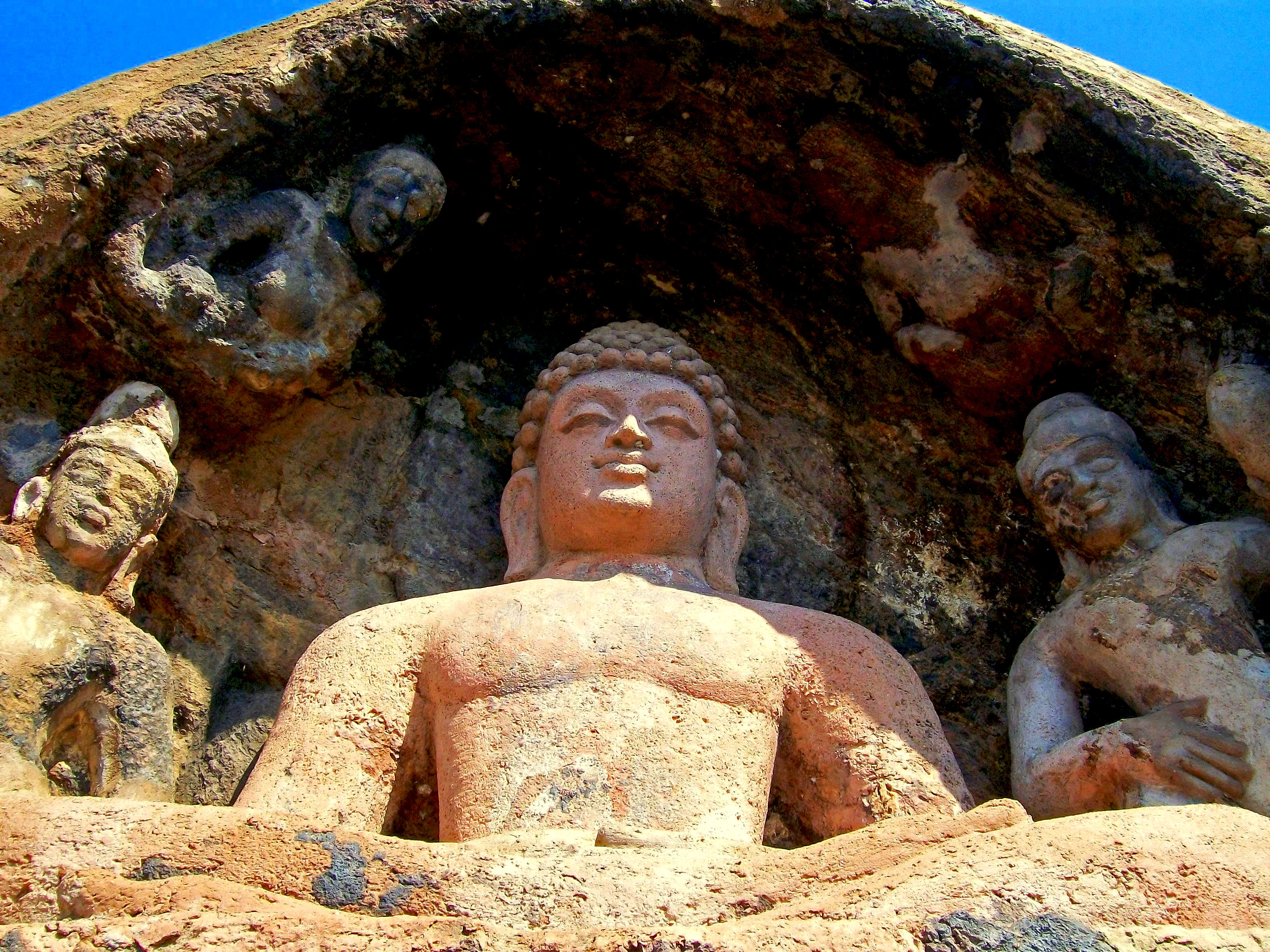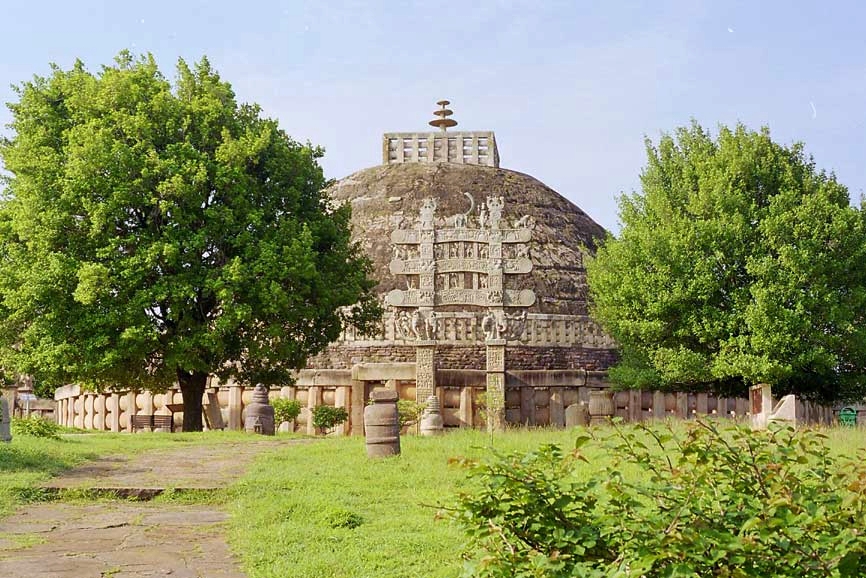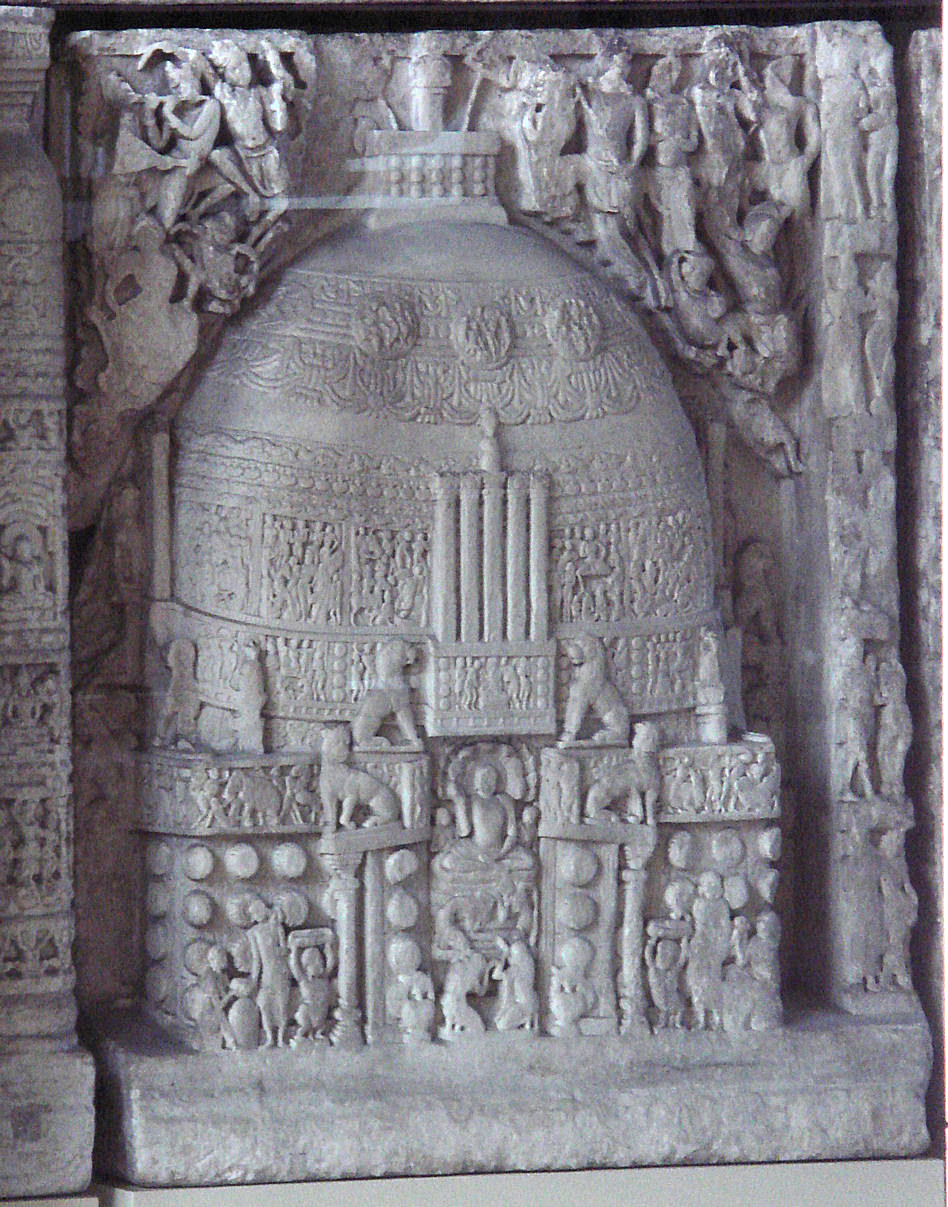Caitika on:
[Wikipedia]
[Google]
[Amazon]


 Caitika () was an early Buddhist school, a sub-sect of the
Caitika () was an early Buddhist school, a sub-sect of the
 The southern Mahāsāṃghika schools such as the Caitikas advocated the ideal of the
The southern Mahāsāṃghika schools such as the Caitikas advocated the ideal of the

 Caitika () was an early Buddhist school, a sub-sect of the
Caitika () was an early Buddhist school, a sub-sect of the Mahāsāṃghika
The Mahāsāṃghika (Brahmi script, Brahmi: 𑀫𑀳𑀸𑀲𑀸𑀁𑀖𑀺𑀓, "of the Great Sangha (Buddhism), Sangha", ) was a major division (nikāya) of the early Buddhist schools in India. They were one of the two original communities th ...
. They were also known as the Caityaka sect.
The Caitikas proliferated throughout the mountains of South India
South India, also known as Southern India or Peninsular India, is the southern part of the Deccan Peninsula in India encompassing the states of Andhra Pradesh, Karnataka, Kerala, Tamil Nadu and Telangana as well as the union territories of ...
, from which they derived their name. In Pali
Pāli (, IAST: pāl̤i) is a Classical languages of India, classical Middle Indo-Aryan languages, Middle Indo-Aryan language of the Indian subcontinent. It is widely studied because it is the language of the Buddhist ''Pali Canon, Pāli Can ...
writings, members of this sect and its offshoots were generally referred to as the ''Andhakas'', meaning "of Coastal Andhra
Coastal Andhra, also known as Kosta Andhra (International Alphabet of Sanskrit Transliteration, IAST: Kōstā Āndhra), is a geographic region in the Indian state of Andhra Pradesh, comprising the coastal districts of the state between the East ...
".
History
The Caitikas branched off from the main Mahāsāṃghika school in the 1st or 2nd century BCE. Epigraphic evidence of the Mahāsāṃghikas in theMathura
Mathura () is a city and the administrative headquarters of Mathura district in the states and union territories of India, Indian state of Uttar Pradesh. It is located south-east of Delhi; and about from the town of Vrindavan. In ancient ti ...
region dates to the first century BCE, and the ' dates the formation of the Caitikas to 300 years after the Buddha. However, the ancient Buddhist sites in the lower Kṛṣṇa Valley, including Amarāvati Stupa, Nāgārjunakoṇḍā and Jaggayyapeṭa "can be traced to at least the third century BCE, if not earlier."
The Caitikas gave rise to the Aparaśailas and Uttaraśailas (also called Pūrvaśailas). Together, they comprised an important part of the Mahāsāṃghika located in South India. Two other sub-sects associated with the Caitikas include the Rājagirikas and the Siddhārthikas, both of which emerged from the Andhra region around 300 CE.
The Caitikas are said to have had in their possession the Great Stupa at Sanchi
Sanchi Stupa is a Buddhist art, Buddhist complex, famous for its Great Stupa, on a hilltop at Sanchi Town in Raisen District of the States and territories of India, State of Madhya Pradesh, India. It is located, about 23 kilometers from Raisen ...
. The Great Stūpa was first commissioned by Asoka
Ashoka, also known as Asoka or Aśoka ( ; , ; – 232 BCE), and popularly known as Ashoka the Great, was Emperor of Magadha from until his death in 232 BCE, and the third ruler from the Mauryan dynasty. His empire covered a large p ...
in the 3rd century BCE and became known as a Buddhist pilgrimage
The most important places in Buddhism are located in the Indo-Gangetic Plain of southern Nepal and northern India. This is the area where Gautama Buddha was born, lived, and taught, and the main sites connected to his life are now important plac ...
site. In the Ajaṇṭā Caves, the only epigraphic reference to an early Buddhist sect is to that of the Caitikas, which is associated with an iconic image in Cave 10. The Mahāsāṃghikas were generally associated with the early veneration of anthropomorphic Buddha images.
When Xuanzang
Xuanzang (; ; 6 April 6025 February 664), born Chen Hui or Chen Yi (), also known by his Sanskrit Dharma name Mokṣadeva, was a 7th-century Chinese Bhikkhu, Buddhist monk, scholar, traveller, and translator. He is known for the epoch-making ...
visited Dhānyakaṭaka, he wrote that the monks of this region were Mahāsāṃghikas, and mentions the Pūrvaśailas specifically. Near Dhānyakaṭaka, he met two Mahāsāṃghika bhikṣus and studied Mahāsāṃghika abhidharma
The Abhidharma are a collection of Buddhist texts dating from the 3rd century BCE onwards, which contain detailed scholastic presentations of doctrinal material appearing in the canonical Buddhist scriptures and commentaries. It also refers t ...
with them for several months, during which time they also studied various Mahāyāna śāstra
''Śāstra'' ( ) is a Sanskrit word that means "precept, rules, manual, compendium, book or treatise" in a general sense.Monier Williams, Monier Williams' Sanskrit-English Dictionary, Oxford University Press, Article on 'zAstra'' The word is ge ...
s together under Xuanzang's direction.
Doctrine
 The southern Mahāsāṃghika schools such as the Caitikas advocated the ideal of the
The southern Mahāsāṃghika schools such as the Caitikas advocated the ideal of the bodhisattva
In Buddhism, a bodhisattva is a person who has attained, or is striving towards, '' bodhi'' ('awakening', 'enlightenment') or Buddhahood. Often, the term specifically refers to a person who forgoes or delays personal nirvana or ''bodhi'' in ...
, the bodhisattvayāna
Mahāyāna ( ; , , ; ) is a term for a broad group of Buddhist traditions, Buddhist texts#Mahāyāna texts, texts, Buddhist philosophy, philosophies, and practices developed in ancient India ( onwards). It is considered one of the three main ex ...
, over that of the arhat
In Buddhism, an ''Arhat'' () or ''Arahant'' (, 𑀅𑀭𑀳𑀦𑁆𑀢𑁆) is one who has gained insight into the true nature of existence and has achieved ''Nirvana (Buddhism), Nirvana'' and has been liberated from the Rebirth (Buddhism ...
or śrāvakayāna
''Śrāvakayāna'' (; ; ) is one of the three '' yānas'' known to Indian Buddhism. It translates literally as the "vehicle of listeners .e. disciples. Historically it was the most common term used by Mahāyāna Buddhist texts to describe one ...
, and they viewed arhats as being fallible and still subject to ignorance. The main Caitika school, along with the Aparaśailas and Uttaraśailas, all emphasized the transcendental and supernatural character of the Buddha.
Xuanzang considered the Mahāsāṃghika doctrine of a ''mūlavijñāna'' ("root consciousness") to be essentially the same as the Yogacara
Yogachara (, IAST: ') is an influential tradition of Buddhist philosophy and psychology emphasizing the study of cognition, perception, and consciousness through the interior lens of meditation, as well as philosophical reasoning (hetuvidyā). ...
doctrine of the ālāyavijñāna "storehouse consciousness". He also noted that the doctrine of the ''mūlavijñāna'' was contained in the āgamas of the Mahāsāṃghikas.
Relationship to Mahāyāna
Associations
A. K. Warder holds that the Mahāyāna "almost certainly" first developed from the southern Mahāsāṃghika schools of the Āndhra region, among monastic communities associated with the Caitikas and their sub-sects. Anthony Barber and Sree Padma note that "historians of Buddhist thought have been aware for quite some time that such pivotally important Mahayana Buddhist thinkers asNāgārjuna
Nāgārjuna (Sanskrit: नागार्जुन, ''Nāgārjuna''; ) was an Indian monk and Mahāyāna Buddhist philosopher of the Madhyamaka (Centrism, Middle Way) school. He is widely considered one of the most important Buddhist philosoph ...
, Dignāga
Dignāga (also known as ''Diṅnāga'', ) was an Indian Buddhist philosopher and logician. He is credited as one of the Buddhism, Buddhist founders of Indian logic (''hetu vidyā'') and Buddhist atomism, atomism. Dignāga's work laid the grou ...
, Candrakīrti, Āryadeva
Āryadeva (fl. 3rd century CE) (; , Chinese: 提婆 菩薩 ''Tipo pusa'' meaning Deva Bodhisattva), was a Mahayana Buddhist monk, a disciple of Nagarjuna and a Madhyamaka philosopher.Silk, Jonathan A. (ed.) (2019). ''Brill’s Encyclopedia of ...
, and Bhāviveka
Bhāviveka, also called Bhāvaviveka (; ), and Bhavya was a sixth-century (c. 500 – c. 570) madhyamaka Buddhist philosopher.Qvarnström 1989 p. 14. Alternative names for this figure also include Bhavyaviveka, Bhāvin, Bhāviviveka, Bhagavadviv ...
, among many others, formulated their theories while living in Buddhist communities in Āndhra."
Royal patronage
Some early Mahāyāna sūtras reference wealthy female donors and provide evidence that they were developed in the Āndhra region, where the Caitika were predominant. The Mahāyāna ''Mahāmegha Sūtra'', for example, gives a prophecy about a royal princess of the Śatavāhana dynasty who will live in Āndhra, along the Kṛṣṇa River, in Dhānyakaṭaka, seven hundred years after the '' parinirvāṇa'' of the Buddha. Several scholars such asÉtienne Lamotte
Étienne Paul Marie Lamotte (; 21 November 1903 – 5 May 1983) was a Belgian priest and Professor of Greek at the Catholic University of Louvain, but was better known as an Indologist and the greatest authority on Buddhism in the West in his ...
, and Alex and Hideko Wayman, associate the Āndra Ikṣvāku dynasty with patronage of Mahāyāna sūtras.Osto, Douglas. ''Power, Wealth and Women in Indian Mahāyāna Buddhism: The Gaṇḍavyūha-sūtra'' 2011. pp. 114-115 Epigraphic evidence at Nāgārjunikoṇḍa also provides abundant evidence of royal and wealthy female donors.
Prajñāpāramitā
A number of scholars have proposed that the MahāyānaPrajñāpāramitā
A Tibetan painting with a Prajñāpāramitā sūtra at the center of the mandala
Prajñāpāramitā means "the Perfection of Wisdom" or "Transcendental Knowledge" in Mahāyāna. Prajñāpāramitā refers to a perfected way of seeing the natu ...
teachings were first developed by the Caitika subsect of the Mahāsāṃghikas. They believe that the ' originated amongst the southern Mahāsāṃghika schools of the Āndhra region, along the Kṛṣṇa River. Guang Xing states, "Several scholars have suggested that the Prajñāpāramitā probably developed among the Mahāsāṃghikas in southern India, in the Āndhra country, on the Kṛṣṇa River." These Mahāsāṃghikas had two famous monasteries near the Amarāvati and the Dhānyakaṭaka, which gave their names to the schools of the Pūrvaśailas and the Aparaśailas. Each of these schools had a copy of the ''Aṣṭasāhasrikā Prajñāpāramitā Sūtra'' in Prakrit
Prakrit ( ) is a group of vernacular classical Middle Indo-Aryan languages that were used in the Indian subcontinent from around the 5th century BCE to the 12th century CE. The term Prakrit is usually applied to the middle period of Middle Ind ...
. Guang Xing also assesses the view of the Buddha given in the ''Aṣṭasāhasrikā Prajñāpāramitā Sūtra'' as being that of the Mahāsāṃghikas. Edward Conze
Edward Conze, born Eberhard Julius Dietrich Conze (1904–1979), was a scholar of Marxism and Buddhism, known primarily for his commentaries and translations of the Prajñāpāramitā literature.
Biography
Conze's parents, Dr. Ernst Conze (1872 ...
estimates that this sūtra originated around 100 BCE.
Tathāgatagarbha
Brian Edward Brown, a specialist in Tathāgatagarbha doctrines, writes that it has been determined that the composition of the ''Śrīmālādevī Siṃhanāda Sūtra
The ''Śrīmālādevī Siṃhanāda Sūtra'' (, '' of Queen Śrīmālā'') is one of the main early Mahāyāna Buddhist texts belonging to the Tathāgatagarbha sūtras that teaches the doctrines of Buddha-nature and "One Vehicle" through the wo ...
'' occurred during the Āndra Ikṣvāku dynasty in the 3rd century CE as a product of the Mahāsāṃghikas of the Āndhra region (i.e. the Caitika schools). Alex Wayman has outlined eleven points of complete agreement between the Mahāsāṃghikas and the ''Śrīmālā'', along with four major arguments for this association. After its composition, this text became the primary scriptural advocate in India for the universal potentiality of Buddhahood
In Buddhism, Buddha (, which in classic Indo-Aryan languages, Indic languages means "awakened one") is a title for those who are Enlightenment in Buddhism, spiritually awake or enlightened, and have thus attained the Buddhist paths to liberat ...
. Anthony Barber also associates the earlier development of the ''Tathāgatagarbha Sūtra
The ''Tathāgatagarbha Sūtra'' is an influential and doctrinally striking Mahāyāna Buddhist scripture which treats of the existence of the " Tathāgatagarbha" (Buddha-Matrix, Buddha-Embryo, lit. "the womb of the thus-come-one") within all sen ...
'' with the Mahāsāṃghikas, and concludes that the Mahāsāṃghikas of the Āndhra region were responsible for the inception of the Tathāgatagarbha doctrine.
Bodhisattva canons
In the 6th century CE, Bhāviveka speaks of the Siddhārthikas using a Vidyādhāra Piṭaka, and the Aparaśailas and Uttaraśailas (Pūrvaśailas) both using a Bodhisattva Piṭaka, implying collections of Mahāyāna texts within these Caitika schools. During the same period, Avalokitavrata speaks of the Mahāsāṃghikas using a "Great Āgama Piṭaka", which is then associated with Mahāyāna sūtras such as the ''Prajñāparamitā'' and the '' Ten Stages Sutra''. Avalokitavrata also states that Mahāyāna sūtras such as the ''Prajñāparamitā'' were recited by the Aparaśailas and the Pūrvaśailas. According to the Theravādin text ''Nikāyasaṅgraha'', the large Mahāyāna collection called the ''Mahāratnakūṭa Sūtra
275px, A decorative page of a Korean copy of the Heap of Jewels Sutra
The ''Mahāratnakūṭa Sūtra'' (Sanskrit; , Tib. ''dam-chos dkon-mchog-brtsegs-pa'') is a major ancient collection of Indian Mahāyāna Buddhist sūtras. It is also know ...
'' (Taishō Tripiṭaka
The ''Taishō Tripiṭaka'' (; Japanese: ''Taishō Shinshū Daizōkyō''; " Taishō Revised Tripiṭaka") is a definitive edition of the Chinese Buddhist canon and its Japanese commentaries used by scholars in the 20th century. The name is abbr ...
, 310) was composed by the "Andhakas", meaning the Caitika schools of the Āndhra region. This collection includes the ''Śrīmālādevī Siṃhanāda Sūtra'', the '' Longer Sukhāvatīvyūha Sutra'', the ''Akṣobhyavyūha Sūtra'', a long text called the ''Bodhisattva Piṭaka'', and others. The ''Mahāratnakūṭa'' collection totals 49 Mahāyāna sūtras, divided into 120 fascicles in the Chinese translation.
Disputes with Theravāda
In the Mahāvihara tradition of theTheravāda
''Theravāda'' (; 'School of the Elders'; ) is Buddhism's oldest existing school. The school's adherents, termed ''Theravādins'' ( anglicized from Pali ''theravādī''), have preserved their version of the Buddha's teaching or '' Dhamma'' in ...
school, Buddhaghoṣa
Buddhaghosa was a 5th-century Sinhalese Theravādin Buddhist commentator, translator, and philosopher. He worked in the great monastery (''mahāvihāra'') at Anurādhapura, Sri Lanka and saw himself as being part of the Vibhajyavāda school ...
grouped the Caitika schools in the Āndhra region, such as the Rājagirikas and the Siddhārthikas, as the "Andhakas". Works such as the ''Kathāvatthu
Kathāvatthu (Pāli) (; abbreviated Kv, Kvu; ) is a Buddhist scripture, one of the seven books in the Theravada Abhidhamma Pitaka. The text contrasts the orthodox Theravada position on a range of issues to the heterodox views of various interlocu ...
'' show that Mahāvihara polemics were directed overwhelmingly at these "Andhakas" in India.
Textual authenticity
The Caitika schools rejected the post-Asokan texts that were in use by theAnuradhapura Maha Viharaya
The Anuradhapura Maha Viharaya was an important mahavihara or large Buddhist monastery for Theravada Buddhism in Sri Lanka. King Devanampiya Tissa of Anuradhapura (247–207 BCE) founded it in his capital city of Anuradhapura. Monks such as B ...
tradition such as the '' Parivara'', the six books of Abhidharma
The Abhidharma are a collection of Buddhist texts dating from the 3rd century BCE onwards, which contain detailed scholastic presentations of doctrinal material appearing in the canonical Buddhist scriptures and commentaries. It also refers t ...
, the '' Patisambhidamagga'', the ''Niddesa
The Niddesa (abbrev., "Nidd") is a Buddhist scripture, part of the Pali Canon of Theravada Buddhism
Buddhism, also known as Buddhadharma and Dharmavinaya, is an Indian religion and List of philosophies, philosophical tradition based on Pr ...
'', some Jataka tales
The ''Jātaka'' (Sanskrit for "Birth-Related" or "Birth Stories") are a voluminous body of literature native to the Indian subcontinent which mainly concern the previous births of Gautama Buddha in both human and animal form. Jataka stories we ...
, some verses, and so on. For example, the Caitikas claimed that their own Jataka tales represented the original collection before the Buddhist tradition split into various lineages.
Interpretation of Buddhist texts
One dispute recorded in the ''Kathāvatthu'' between the Mahāviharavasins and the Andhakas was a fundamental matter concerning the interpretation of the Buddha's teachings. The Andhakas are said to have held that the Buddha's actions and speech were supramundane, but some may only perceive the conventional or mundane interpretation. For the Mahāsāṃghika branch of Buddhism, the ultimate meaning of the Buddha's teachings was "beyond words", and words were merely a conventional exposition of the Dharma. The Theravāda Mahāviharavasins, in contrast, argued that literal interpretations of the Buddha's teachings were best.Buescher, John. ''Echoes from an Empty Sky: The Origins of the Buddhist Doctrine of the Two Truths.'' 2005. p. 46See also
*Index of Buddhism-related articles
0–9
* 22 Vows of Ambedkar
A
* Abhayagiri Buddhist Monastery
* Abhayamudra
* Abhibhavayatana
* Abhidhajamahāraṭṭhaguru
* Abhidhamma
* Abhidhamma Pitaka
* Abhidharmakośa-bhāsya
* Abhijatabhivamsa
* Abhijna
* Acala
* Acariya
* Acc ...
*Nikaya Buddhism
The term Nikāya Buddhism was coined by Masatoshi Nagatomi as a non-derogatory substitute for Hinayana, meaning the early Buddhist schools. Examples of these groups are pre-sectarian Buddhism and the early Buddhist schools. Some scholars exclud ...
*Schools of Buddhism
The schools of Buddhism are the various institutional and doctrinal divisions of Buddhism, which have often been based on historical sectarianism and the differing teachings and interpretations of specific Buddhist texts. The branching of Buddhi ...
* Secular Buddhism
Secular Buddhism, also called agnostic Buddhism and naturalistic Buddhism, is a modern, western movement within Buddhism that leans toward an "exclusive humanism" that rejects "superhuman agencies and supernatural processes" and religious ...
References
Bibliography
* * * * {{Buddhism topics Mahāsāṃghika Nikaya schools History of Andhra Pradesh Early Buddhist schools